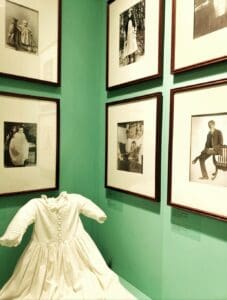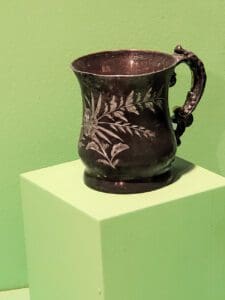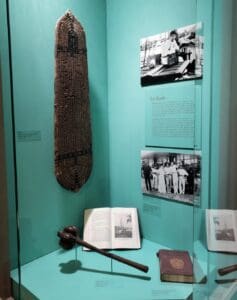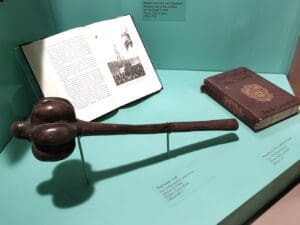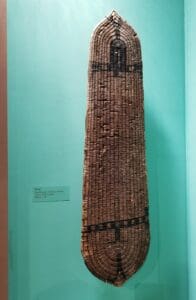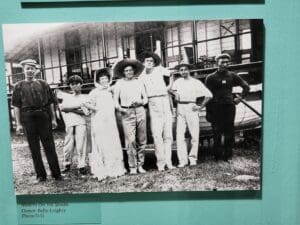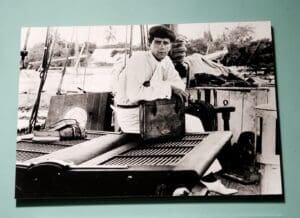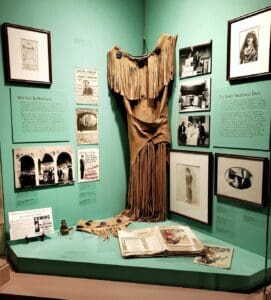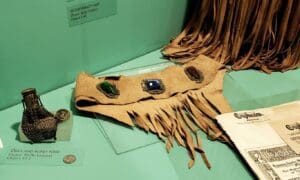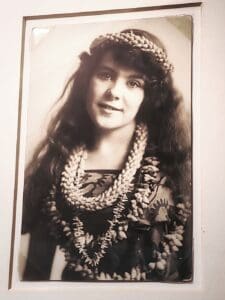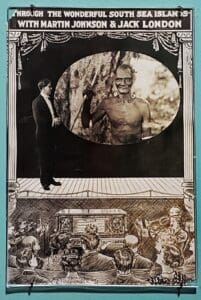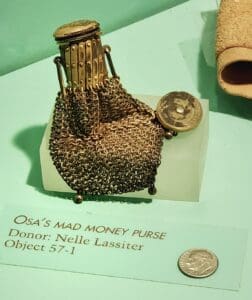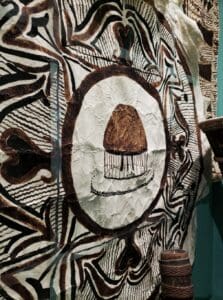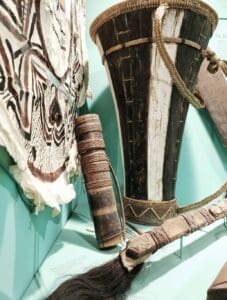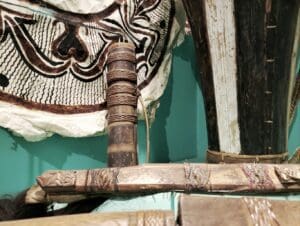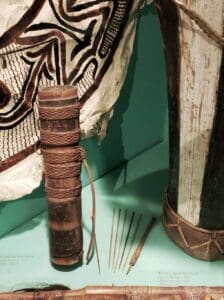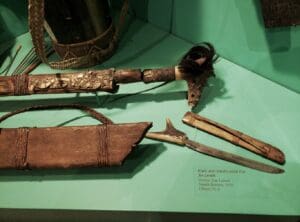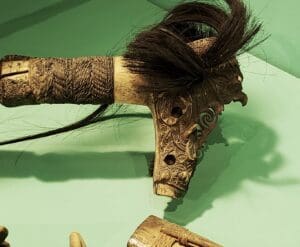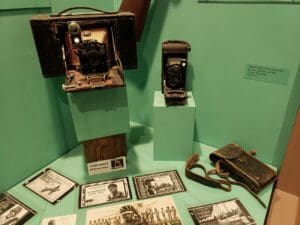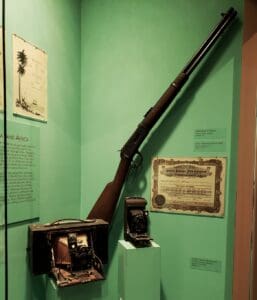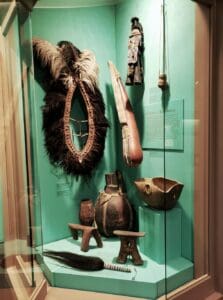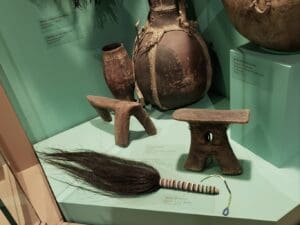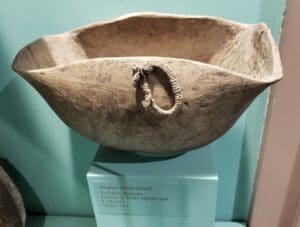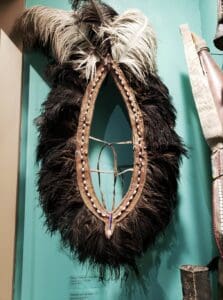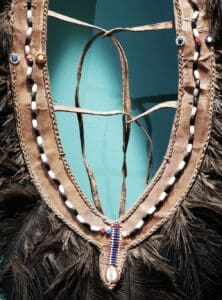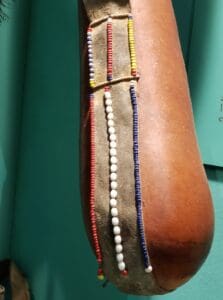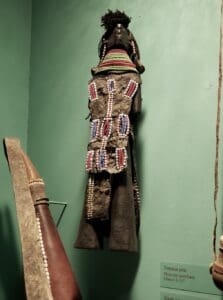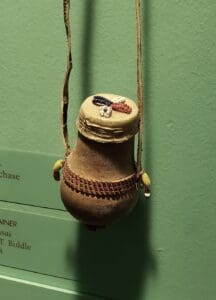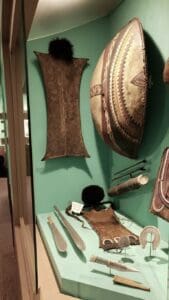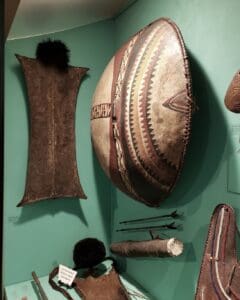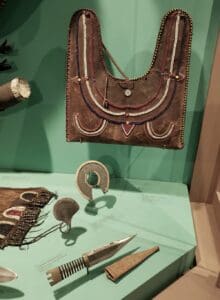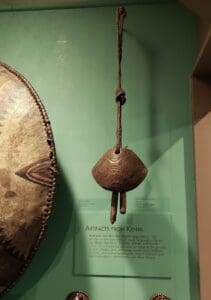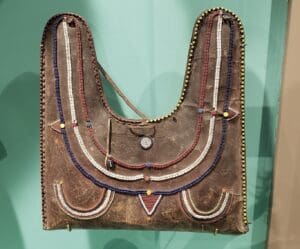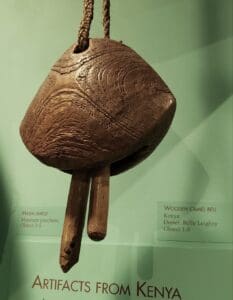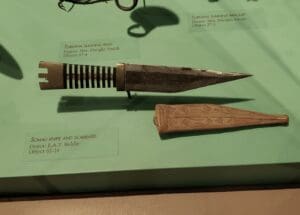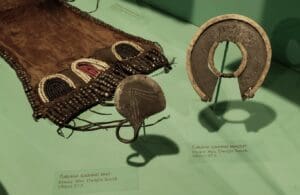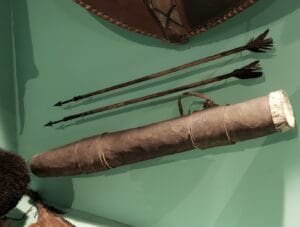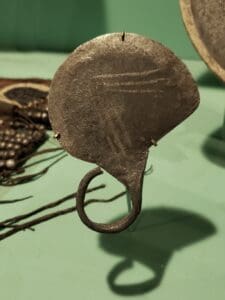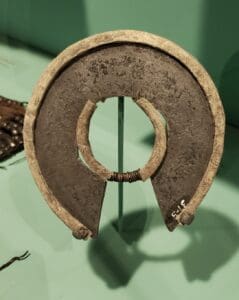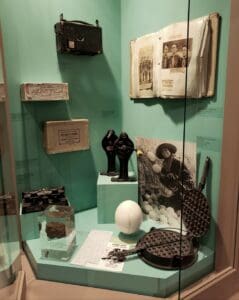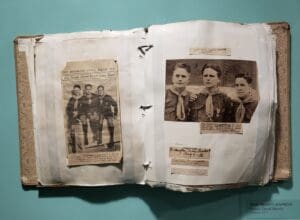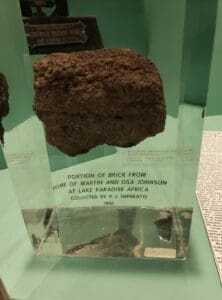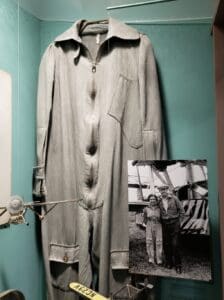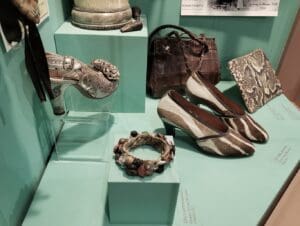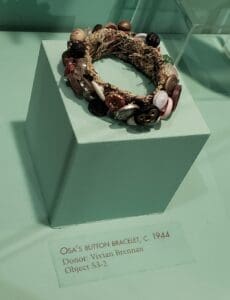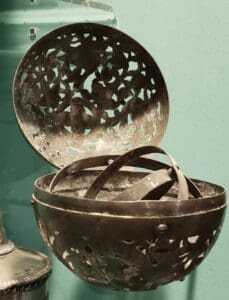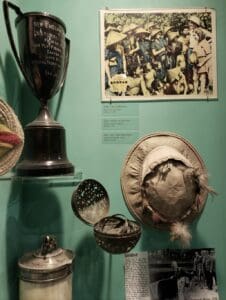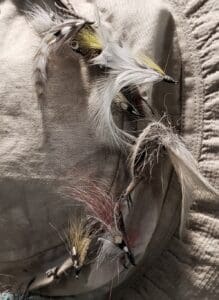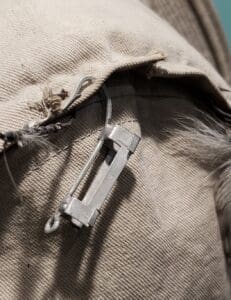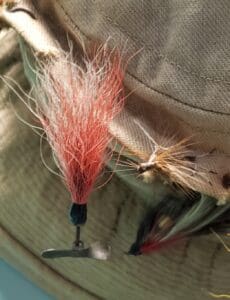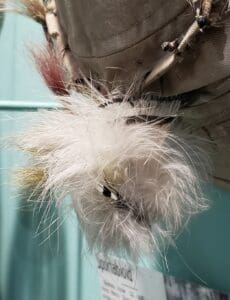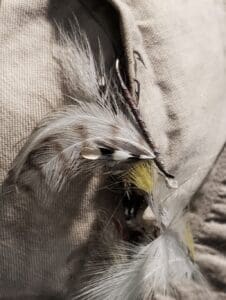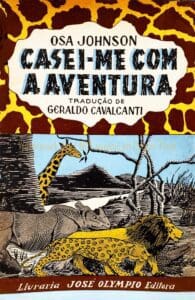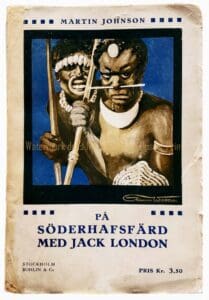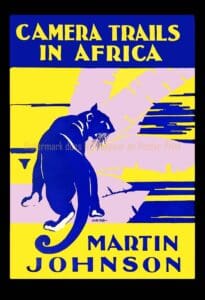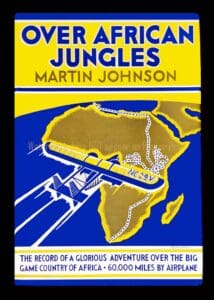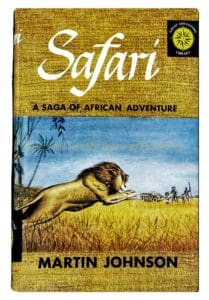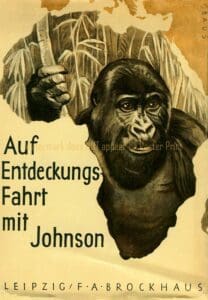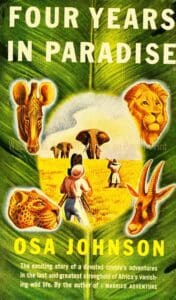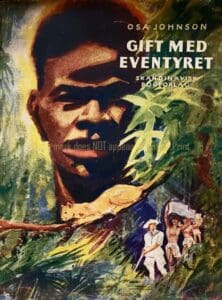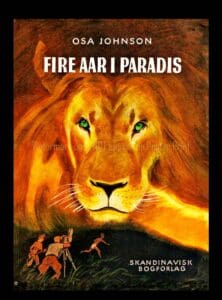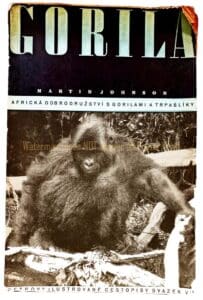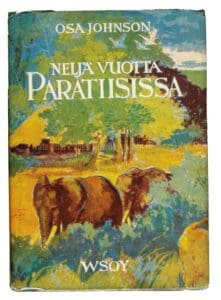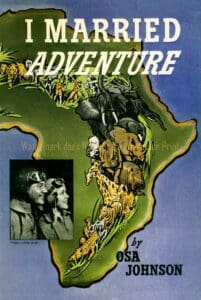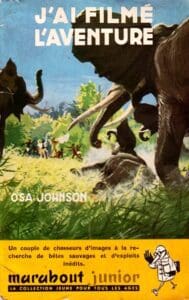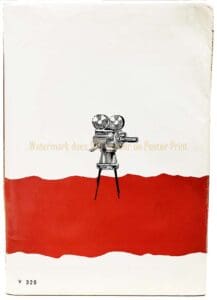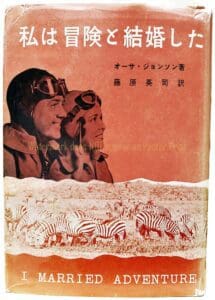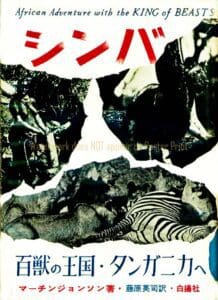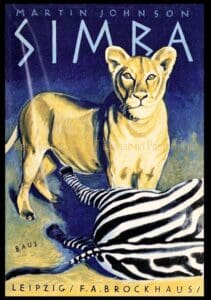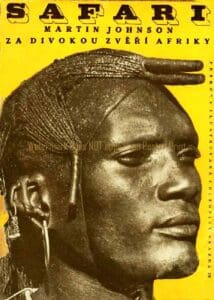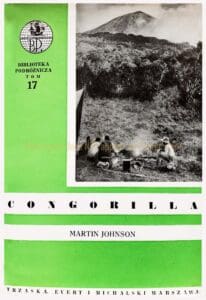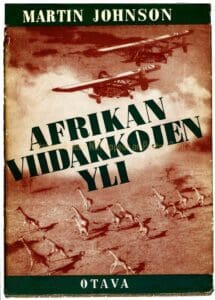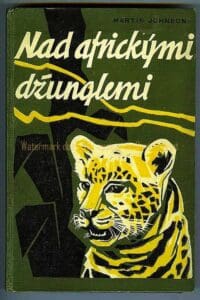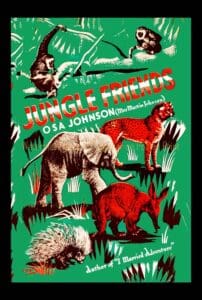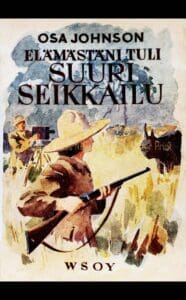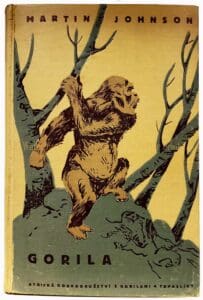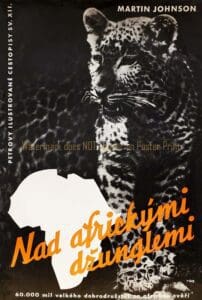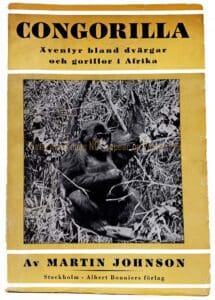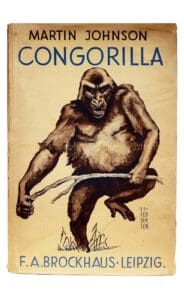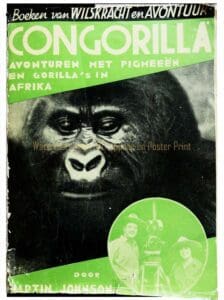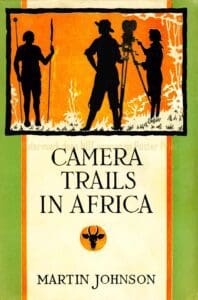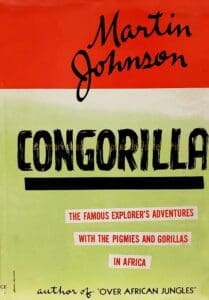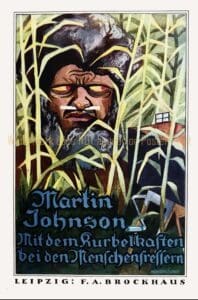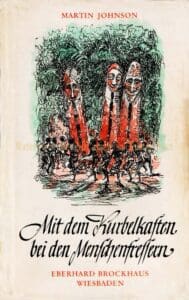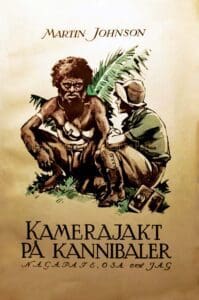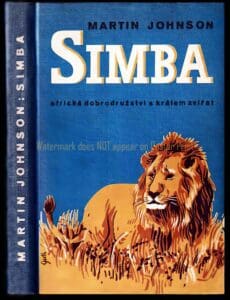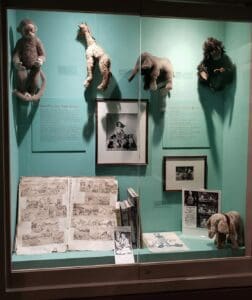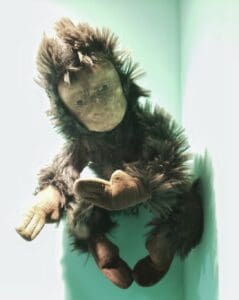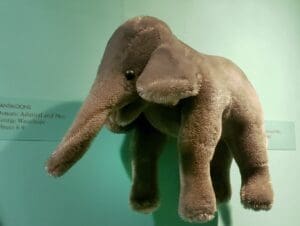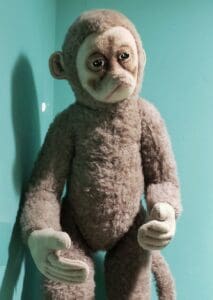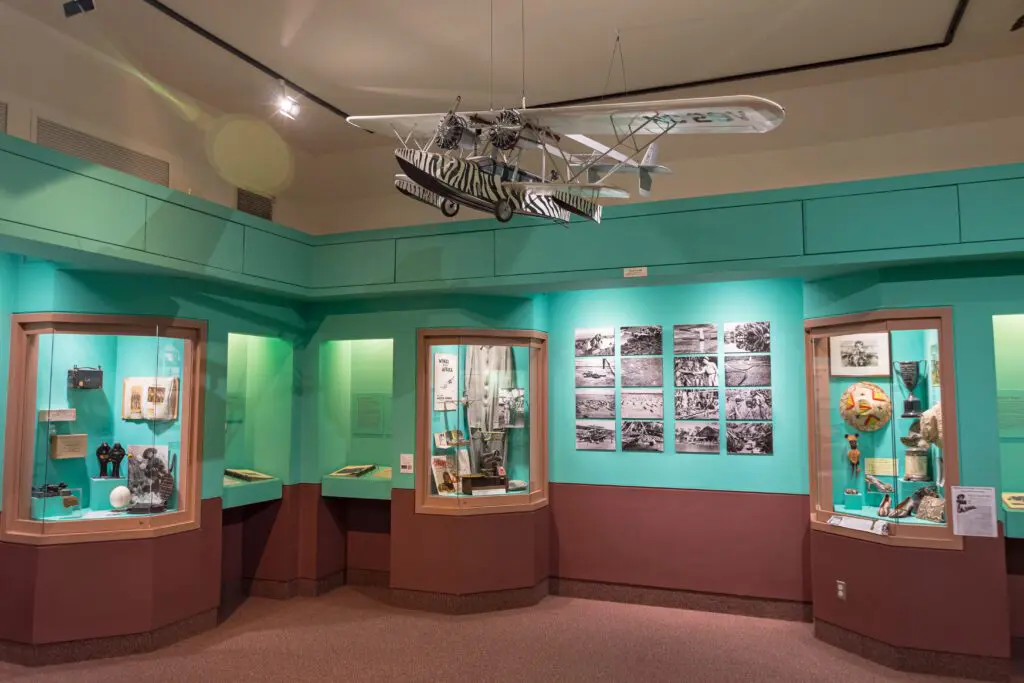JOHNSON GALLERY GUIDE
Above is a short 2:30 min. clip so you can "meet" Martin + Osa Johnson!
After that, this page acts as your Gallery Guide to walk you through the exhibits as a self-tour. Staff are always happy to help answer questions, so please find one of us if you have any questions about Martin + Osa or the art and artifacts in their museum.
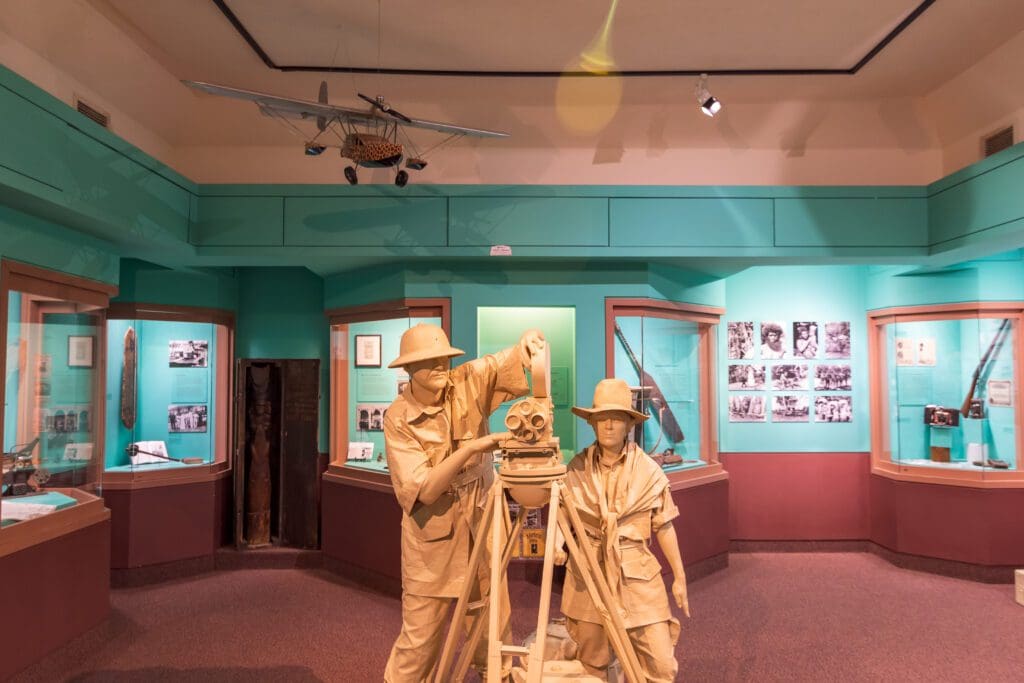
As you enter the Johnson Gallery from the stairs, you will find it begins, as the Johnsons did, at their birthplaces. Although Martin was born in Rockford, Illinois, he considered himself a Kansan, as do we. Martin's youth, spent in Lincoln and Independence Kansas and Osa's in her birthplace of Chanute, are shown and discussed in this wall exhibit, along with family photos.
CASE 1
The photographs of Martin and Osa's youth are accompanied by Osa's Baby Cup, 1-32, and Martin's Christening Dress, 2-1, which always causes disbelief among our younger visitors as it's so small for such a large man. The photograph of Mr. Johnson in his jewelry store is a reminder of the genesis of Martin's photography. Later, Mr. Johnson sold the store and its contents so that he might help finance Martin and Osa's first trip to Africa and so he might go with them on one of their adventures.
CASE 2
Martin's trip to the South Seas with Jack and Charmian London was made before he met Osa. The Snark, for which our museum "theater" is named, was the name of the boat London had constructed for the trip. The trip was delayed until 1907 by the occurrence of the San Francisco earthquake in 1906.
Martin, had been hired as a cook, but they ate little on the first leg of the voyage, to Hawaii, because of the weather. The Londons then found Martin more useful as a seaman/photographer than a chef so he was reassigned. The Londons became ill in the Solomon Islands and the "trip around the world" ended in Australia. Martin remained to sell the Snark and importantly, met several French film makers from Pathé Freres. He went with them on a trip to film the Solomon Islands and learned the craft of making motion pictures. Martin continued his trip around the world, stopping in Paris where he worked at an amusement park and with Pathé Freres for awhile.
Above is a brief clip showing archival footage concerning Martin's trip with Jack London, and his return to Kansas where he met Osa Leighty.
Objects and photos in Case 2 & 3 appear in cameos in this film.
CASE 3
The Housepost, or as Martin called it for theatrical flair, the devil-devil, located between Case 1 and Case 2 was part of his South Seas exhibit as he showed his films and slides at the "Snark Theater" which he and a friend opened in Independence, Kansas. It was there that he met local singer and dancer Osa Leighty as she substituted for his regular singer. After a whirlwind three week courtship, they fell in love and eloped to Kansas City.
The Housepost can be seen in the photo of the Snark Theatre in Case 3, center of the the three images on the north wall.
The "Indian" dress was one of Osa's costumes during her portion of the Snark travelogues. The little silver purse was just large enough for a girl's "mad money." Later, when they went on the road, Osa used the purse to collect dime admissions for shows at very small venues that had no ticket booth.
The Johnsons performed just a few months in Independence, then decided to put their show on the road. After several months of making just enough to get by, they became a part of the Orpheum Vaudeville Circuit and played on the program with many well-known people: W. C. Fields and Will Rogers among them. Martin showed his pictures and did the narration and Osa sang and they saved their money for another trip. Back in New York, Martin worked in Orpheum's film lab and Osa took in roomers to whom she served breakfast.
This clip covers the Johnson's first south seas expedtion in 1917 as well as their return in 1919.
Since Martin + Osa did not collect art or artifacts, until recently we did not have enough pieces to cover these trips in this exhibition. Thanks to a number of single item and large donations after moving the museum to the depot, we were able to renovate and launch the Oceania Gallery on the first floor during the the centenial of the Johnson's second trip in 2019.
The clip below covers the Johnson's first expedtion to North Borneo in 1920.
The museum has developed a Sister Museum partnersip with the Sabah Museum in Malaysia and has participated in several curatorial exchanges to help update the history and cultural significance of the Johnson's vast Visual History legacy of North Borneo.
CASE 4
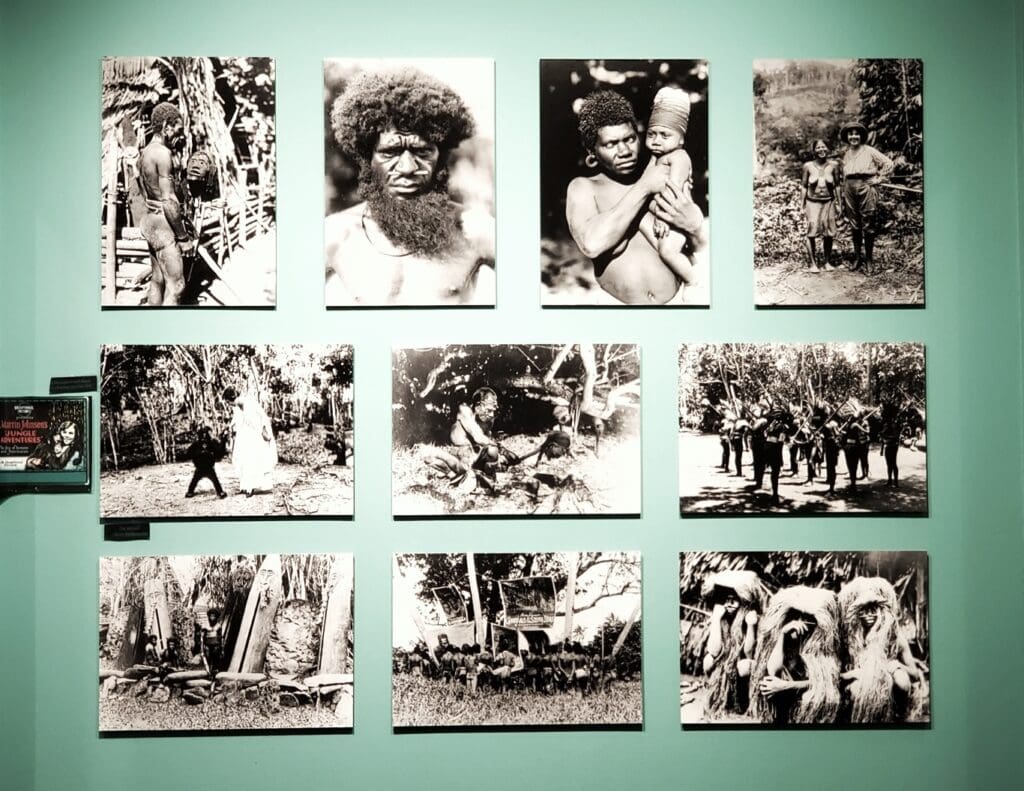
SOUTH SEAS WALL PHOTOS
2. Nagapate, Big Namba Chief (Malekula, New Hebrides) #1082.82
3. Toman mother & baby (Toman Island, New Hebrides)#108227.1
4. Osa with Romanau woman (British North Borneo) #108451
5. Osa and Bessie (British North Borneo) #108483
6. Toman Headdryer &head (Toman Island, New Hebrides)#108254
7. Tethlong's dancers (Malekula, New Hebrides) #108176.1
8. Nagapate; two of his men, ceremonial slit drums (Vao Island, New Hebrides) #108281
9. Nagapate; men viewing posters of themselves on Johnsons' second trip (Malekula, New Hebrides) #108213
10. Nagapate and his wives (Malekula, New Hebrides) #252400.2
CASE 5
The cameras in this exhibit are the only Johnson-owned cameras in our collection. Martin had marvelous cameras and had his lenses made for him in England and Germany. Some of these lenses were later given to the United States government for use in World War II.
The Winchester 30-30 is the only Johnson gun in our collection and as with the cameras, the Johnsons had some amazing guns. These, however, were all sold in each of their estate sales. Currently, we have a museum member in Colorado who is trying to trace then all. The wall photographs of the first trip to Africa are given titles in the next album.
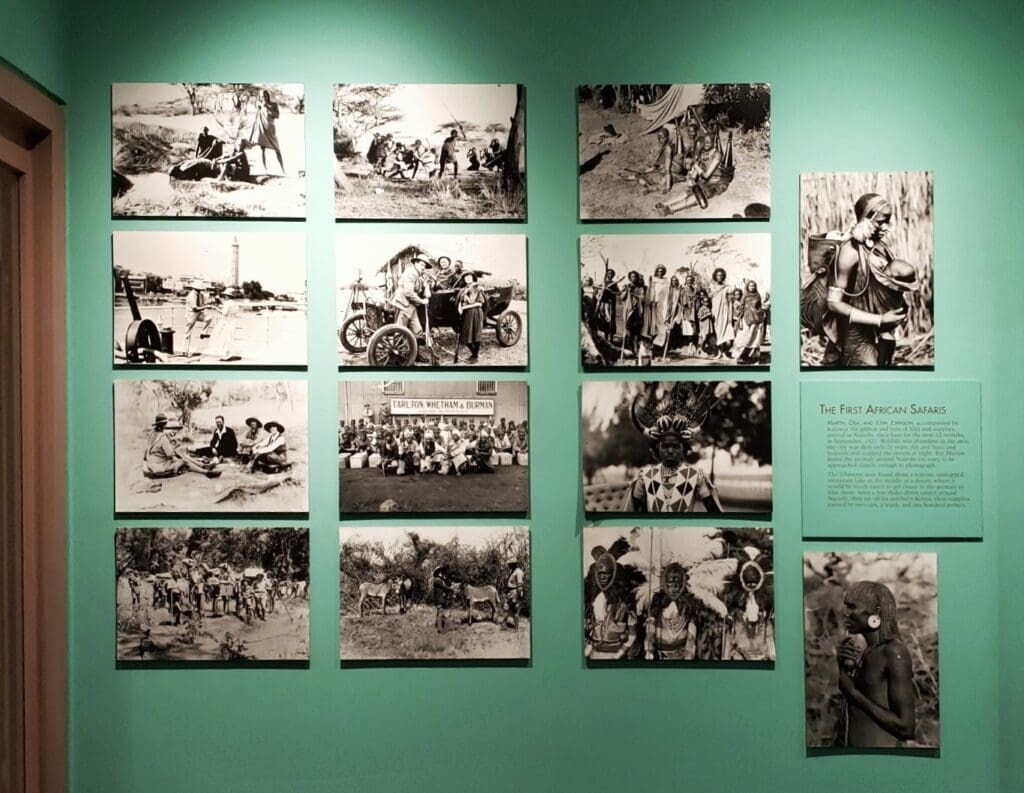
FIRST AFRICAN SAFARI WALL CAPTIONS
1. Men drinking at waterhole (Kenya) #119BJ
2. Masai war games (Amboseli Area, Kenya) #79BJ
3. Masai women with gourds (Amboseli area, Kenya) #166J
4. Kikuyu mother and baby (Nairobi) #352J
5. Kalawat, world traveling gibbon ape and friends #251530
6. The Johnsons, Mr. Walsh, Kalawat and safari car #217J
7. Boran people (Northern Kenya) #1845J
8. Duke and Duchess of York (later King George & Queen Elizabeth)#554JN
9. Outfitters, Tarleton, Whetham and Burman (Nairobi) #49J
10. Rickshaw driver in costume (Durban, South Africa) #877J
11. Arrival at Lake Paradise, Marsabit (N. Frontier, Kenya) #140J
12. Osa, Rattray and three Grevy's zebra colts (Isiolo, Kenya) #113J
13. Meru Moran men (Meru, Kenya) #153BJ
14. Rendille man (Northern Frontier, Kenya) #1977
CASE 6
All these pieces were donated to the museum as they are all related to people who inhabited the areas near Lake Paradise. This is also true of the objects in the next exhibit.
Turkana men took great pride in their structured hair arrangements which were stabilized with tallow and mud. Neckrests, like object 35-3, were carried so the hair would be protected from the ground as they slept. The Doll, 3-157, is dressed as a Turkana woman would be. The Containers, 3-72 and 3-137, along with the Dish, 23-1, are examples of the Turkana's ability to adapt natural materials for practical use. The Fly Switch, 62-12, would be used by the older men. The switch is a wildebeest tail.
The intervening album features photographs from the Johnsons lives at Lake Paradise. Over the door into the hall are two Spears: 61-1 a Samburu spear, and 62-5 a Turkana spear.
CASE 7
The following exhibit consists almost entirely of weapons. Of particular interest are the Turkana Slashing Ring, 37-4, the Slashing Bracelet, 37-5 and the Woman's Skirt, 62-1. The bag hanging on the wall is a Masai woman's Jewelry Bag, 62-4, and the Wooden Bell, 1-5, is for a camel.
The clip below is the opening to CONGORILLA, the first sound film ever produced entirely in Africa. Martin + Osa Johnson were making sound pictures in the field when Hollywood was still struggling to control it in the studio.
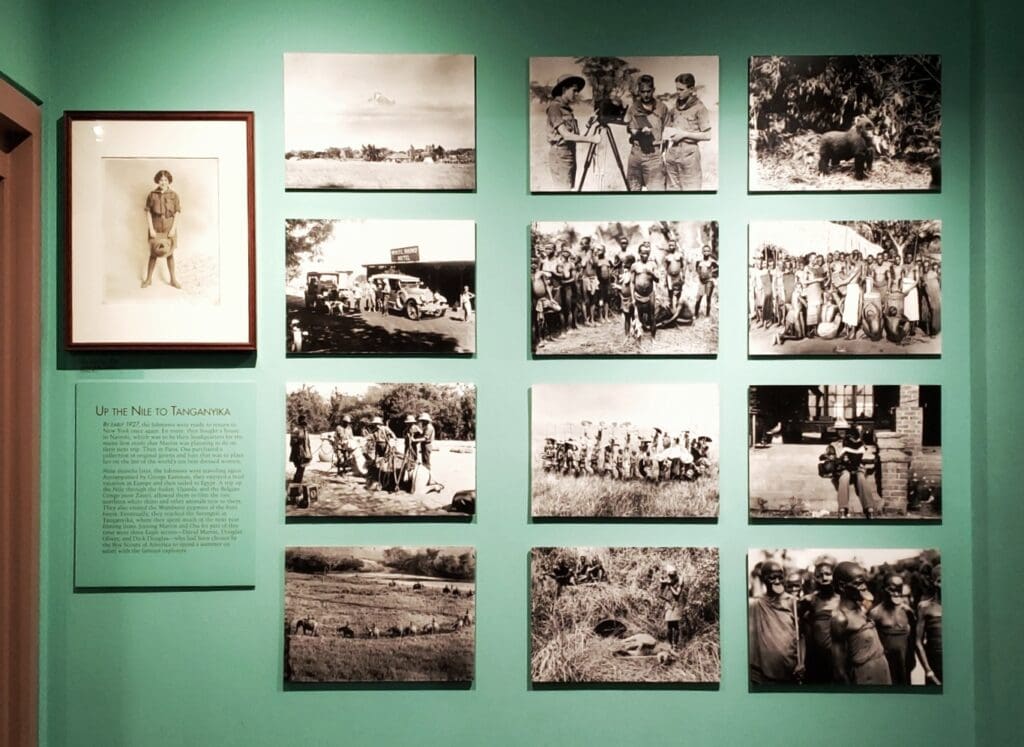
NILE & TANGANYIKA WALL CAPTIONS
The wall exhibit is of the Johnson photographs primarily of the Belgian Congo (then Zaire and now the Democratic Republic of the Congo) whose titles are listed in the next album. The photograph of Osa in her camping outfit was taken when she was 29 and before they spent four years at Lake Paradise.
1. Mt. Kenya (from Nanyuki) (Kenya) #2324.1
2. The three visiting American Boy Scouts and camera #538B
3. Gorilla photographed in Virunga Mountains (Belgian Congo) #999E
4. White Rhino Hotel (Kenya) #459A
5. Mbuti drummer (Ituri Forest, Belgian Congo) #213B
6. Watutsi men and drums (Belgian Congo) #774E
7. George Eastman, Dr. Stewart, camels for safari and men (N.F.D.)#602A
8. Lumbwa (Kipsigi) circled around their lion kill (Kenya) #718A
9. Martin Johnson holding Snowball, Bebe & Teddy #1116E
10. Elephants at a Belgian training camp in Northeastern Belgian Congo#173B
11. Lumbwa playing his "horn" horn over lion kill (Kenya) #779A
12. Women from the Ubangi Tribe. Lip stretching as shown here is no longer
practiced today. (Uganda) #7001E
The adjoining photographic albums are about the trip to the Belgian Congo and "The Flying Safari."
CASE 8
This case has a mix of Johnsonian artifacts and pieces donated by family and others from around the world. Martin's Film Rewind Reels, 6-7, his Film Splicer, 6-6, the Film Box, 1-109 and Photographic Printing Paper Box, 1-108 were also used by Martin and donated by Osa's mother Belle.. The Movie Camera, 68-1, was sent to us from South Africa by the daughter of a man who hauled supplies from Nairobi to Lake Paradise and to whom Martin had given the camera.
The Ostrich Egg, 4-1, is real with the white and yoke removed. Scenes of Osa preparing ostrich egg breakfasts for Martin and their safari mates can be seen in several of their feature films. Dr. Imperato, long time Johnson fan and donor of the majority of the museum's West African collection, had the Building Remnant, 17-145, of adobe from the Johnsons stay at Lake Paradise enclosed in lucite. David Martin, one of the three boy scouts who spent their summer vacation with the Johnsons, sent the Scrapbook, 13-1. The Waffle Iron, 38-1, was given to Dr. Imperato in Kenya when he advertised for anyone who had known the Johnsons. Osa had given Mrs. McCaldin the waffle iron, which she had purchased at Montgomery Ward in Chanute, when she left Africa. Mrs. McCaldin thought it should be returned to Chanute and given to the Johnsons' museum.
This clip shows some of the amazing footage from the Johnson's African Flying Safari...it is among the earliest aerial footage of the continent, and is the most encompassing as Martin + Osa flew 60,000 miles from Cape Town to Cairo.
CASE 9
This exhibit displays two Sikorsky Models, 16-1 and 16-2 of Johnsons' airplanes which were made by a local man in the very early years of the museum's life. Also featured here are Martin's Goggles and Case, 1-107A and B, the Johnsons' Flying Licenses, 1-107C and D, and Osa's Flying Suit and Hat, 1-51, which were all donated by Osa's mother, Belle Leighty. The "Wings Over Africa" Lobby Card, 69-1, advertised one of their lectures following this trip. The Map, 5-1 was given by their pilot, Vern Carstens, who said it "was not good for much more than something to sit on" since there were no elevations given and Africa is a mountainous continent.
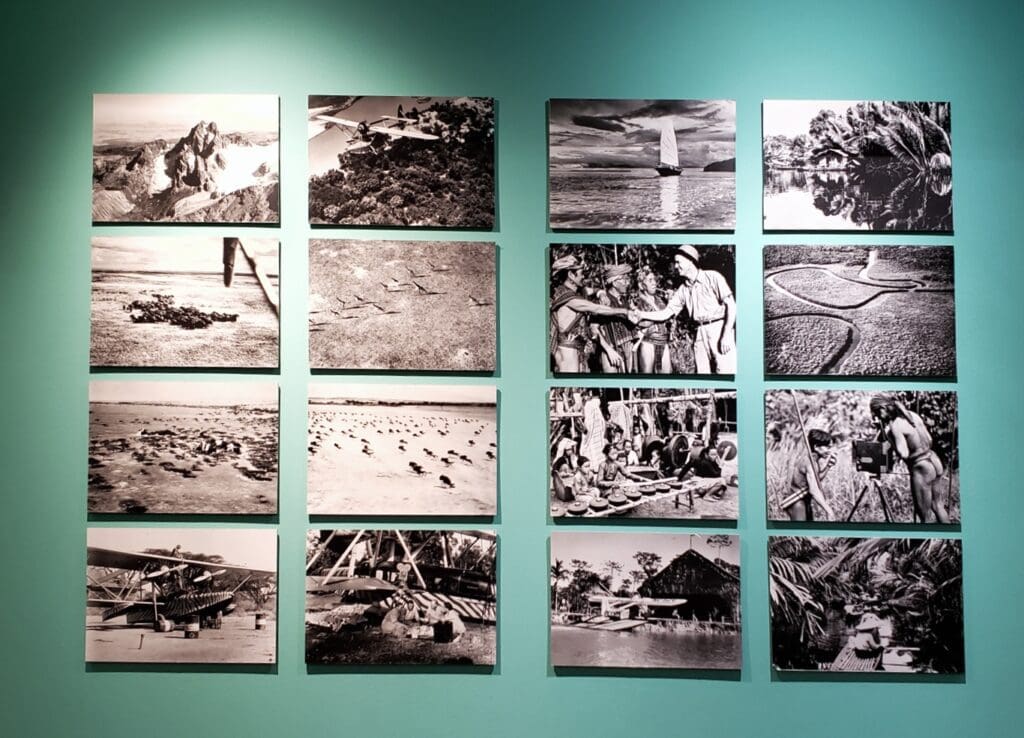
FLYING SAFARI WALL CAPTIONS
The following photographs are divided evenly, the first half of the flying safari and the second of their last trip, to British North Borneo (now Sabah, Malaysia).
1. One of Mt. Kenya's peaks (Martin Johnson, photographer; Vern Carstens, pilot) #311G
2. Spirit of Africa over Tana River (Kenya) #375G
3. Herd of elephant, Lorian Swamp, strut of airplane (Kenya)#25F
4. Giraffe from air (Kenya) #493G
5. Seronera Camp (Tanganyika) #317G
6. Wildebeeste running, (Serengeti) #491G
7. Vern Carstens (pilot) gassing plane (N.F.D.) #923G
8. Bisquick breakfast in the shade of Osa's Ark (near Mt. Kenya) #917G
9. Chinese junk #26H
10. Houseboat in giant palmettos #139H
11. Martin Johnson shaking hands with Tengara #1131H
12. Kinabatangan curves # 151H
13. Philippine orchestra # 2167.1H
14. Two Dunsun men with box camera #1134H
15. Spirit of Africa and Borneo at Abai #1966.1H
16. Boats in palmettos, Kinabatangan River #623H
CASE 10
This exhibit, called "Personal Possessions," includes Osa's Fishing Hat, 1-14, with its flies still in place. She was a dedicated fisherman, proof of which is the Trophy, 52-1, from a contest in Maine 1939.
Also proof of her sportsmanship, style, and repurposing when she had to shoot for food, study or protection are the Zebra Skin Shoes, 53-1, the Python Purse, 1-83, and the Crocodile Purse, 1-86. A zebra was shot for food and zoological study. The head located near the entrance of this exhibit was preserved and sent to the Brooklyn Zoo to help them better care for and identify their own grevy zebras. Osa had Macy's in NYC create the shoes, a belt, two purses and a tote bag out of the skin, further repurposing the skin. Crocodile and python purses were made from animals Osa was requested by local residents to shoot for protection. The crocodile had indeed been a man-eater, as is proved by a photo of a human leg being removed from the croc's stomach after Osa shot it. The photo is in the expedition files, but for obvious reasons we do not display it in exhibits.
The good luck talisman can be seen in several expedition photographs from their Africa days, hanging from the tent flap. Martin used his Cigar Holder, 32-10, and Engraving Tool, 55-4, daily. The Cigar Humidor, 86-3, made of an elephant tusk with silver fittings is one of a pair made in Nairobi. We have been told its twin was given to the Prince of Wales. It was given to the museum by the wife of the man who bought it at the sale following Osa's death. The Ships Light, 54-23, was a gyroscope inside the round frame which kept
the flame level. It was probably fueled by an oil.
Osa's "Cinderella Slipper" is displayed in the hopes of us one day finding the little Prince Charming who received the now missing mate from Osa. The full story is shown in the exhibit, but in summary, Osa was hosting a children's book signing and talk at a hotel and so many children came that it went hours longer than scheduled. Not wanting any child to leave without seeing her and having her sign their program or book, Osa and her mother moved the signing up to her suite so the still long line of children didn't block the Hotel's front desk. Osa had worn these shoes to the talk and her mother remembered her kicking them off and saying she would never wear them again. One little boy arrived at the table but had somehow lost his program so had nothing for Osa to sign. Her mother said Osa picked up silver shoe, signed it and sent the "Charming Little Prince" on his way. Since Belle recorded this story in the 1960s as a part of an oral history project, museum staff and Osa's fans have been seeking the missing mate to the shoe on display here.
CASE 11
The books written by the Johnsons occupy this case and like the films they were popular worldwide. There were 18 books known in 1993 when this exhibit opened, but two "new" original books have since been found. Life-sized murals of Martin and Osa featuring the covers of all 20 books can be found just outside of the museum's entrance inside the lobby, on either side of the exit door that leads to the trackside of the depot.
Our archives house translations of Osa's book I Married Adventure, 1940, in nine foreign languages produced for 22 countries. Martin's books likewise have numerous editions in various languages. Below are just a few examples of the Johnson's books in foreign editions.
CASE 12
The last exhibit case holds Osa's children's books and the stuffed animals sold under the auspices of the Natural Wildlife Federation. We are fortunate to have a collection of the comic strips, Danger Trails. The scrapbook was made by a Mrs. Bean of Thayer, Kansas for her children, who kindly presented it to the museum.
The wall exhibits which follow are of Osa after the death of Martin and of the Johnsons' legacy.
LOOKING UP: SIKORSKY AIRPLANE MODELS & ANIMALS
Looking above, the Eagle Hawk is a popular sight in Africa as is the Grevy's zebra, described in detail in Case 10, which is larger than the Common zebra and has narrow stripes.
The small giraffe S39 replica of Osa's "Spirit of Africa & Borneo" plane is a radio controlled model built and used in Wichita and donated by its builder, Andrew S. Osburne.
The larger plane is a "from scratch" model made by Warren Watson in California, for the muscum. When it was completed, Mr. and Mrs. Watson, packed it carefully in their station wagon and drove it to Chanute.
AROUND THE GALLERY: BUST of MARTIN and MARTIN + OSA STATUES
The bust of Martin was sculpted by Betti Richard, who had known Martin since she was a small child visiting her father's office, which was next to Martin's office, at the American Museum of Natural History in New York.
The replications of Martin and Osa filming were copied from like photographs in our archives. Atta, Inc. of New York modeled figures that resembled the Johnsons, except in their faces. The designers purposely made their faces less defined so they would be as timeless as their photographs. When all was ready with the staues, each was dipped in a resin-epoxy, dried, loaded into a U-haul truck and driven to Chanute.
